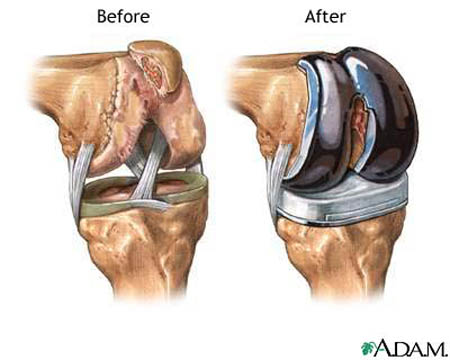Joint Replacement surgery / surgical operation, risks

Joint Replacement is a surgical OPERATION, also called total JOINT replacement, to remove a severely diseased or damaged joint and replace it with a prosthetic joint. OSTEOARTHRITIS and RHEUMATOID ARTHRITIS are often to blame for joint deterioration severe enough to require joint replacement. The most commonly replaced joints are hips, knees, and shoulders. Prosthetic joints are also available for fingers, elbows, and ankles. Prosthetic joints are made of a variety of materials, usually combinations of metals (such as titanium) and plastic composites (such as polyethylene) that are durable, strong, and light.
Joint Replacement - Surgical Procedure
Joint replacement requires a hospital stay of three to seven days. The surgeon performs the operation with the person under general ANESTHESIA. For hip or knee replacement, an option is epidural or spinal anesthesia with sedation for comfort. A joint replacement operation takes about two hours, during which the surgeon makes an incision large enough to adequately expose the joint, cuts away the damaged joint structures, prepares the remaining BONE structure to receive the prosthesis, and cements or otherwise attaches the prosthesis components into place. After the surgeon finishes the operation, the person goes to the recovery unit for close nursing supervision and care until the anesthesia wears off and PAIN control is satisfactory, usually for two to four hours.
Return to activity begins almost immediately and is essential for full recovery of joint function. It is especially important for the person to begin walking right away for hip and knee replacements. The doctor will prescribe ANALGESIC MEDICATIONS for pain relief. Intensive PHYSICAL THERAPY moves the new joint through passive and active range of motion exercises. Frequent walking also reduces the risk for blood clots. The doctor may prescribe medication, support stockings, or inflatable compression cuffs.
Joint Replacement - Risks and Complications
All surgeries carry the risk for excessive bleeding during or after the operation, blood clots, and INFECTION of the surgical wound. A particular risk with joint replacement is infection that infiltrates the bone, causing more extensive damage than a repeat joint replacement could repair. Other potential complications of joint replacement include failure of the prosthesis, loosening of the insertion of the prosthesis into the bone ends, DISLOCATIONS, and loss of function due to wear over time.
Outlook and Lifestyle Modifications
A prosthetic joint has a life expectancy of 5 to 15 years, depending on the joint and the person’s lifestyle. Some strenuous physical activities may no longer be possible, depending on the replaced joint. A replacement hip or knee generally cannot tolerate activities such as running and jumping, for example, though swimming and bicycling are excellent alternatives for aerobic conditioning and improving STRENGTH, ENDURANCE, and FLEXIBILITY. Most people who undergo joint replacement enjoy vastly improved QUALITY OF LIFE after HEALING is complete. Complete rehabilitation and return to normal activities may take three to six months.
See also PATIENT CONTROLLED ANALGESIA; POSTOPERATIVE PROCEDURES; PREOPERATIVE PROCEDURES; PROSTHETIC LIMB; SURGERY BENEFIT AND RISK ASSESSMENT.
Open discussion on the topic Joint Replacement surgery / surgical operation, risks
Similar interests
- Nuovi Casino
- Casinos Not On Gamstop
- UK Casinos Not On Gamstop
- Casinos Not On Gamstop
- UK Casinos Not On Gamstop
- Casino Non Aams Italia
- Slot Sites Not On Gamstop
- Meilleur Casino En Ligne
- Non Gamstop Casino Sites UK
- Meilleur Casino En Ligne
- Casino En Ligne France
- Best Non Gamstop Casinos
- Casinos Not On Gamstop
- UK Casino Not On Gamstop
- Casinos Not Signed Up To Gamstop
- Best Slot Sites UK
- Non Gamstop Casino Sites UK
- Online Casinos Nederland
- Online Casinos Nederland
- Casinos Not On Gamstop
- Best New Uk Casinos Not On Gamstop